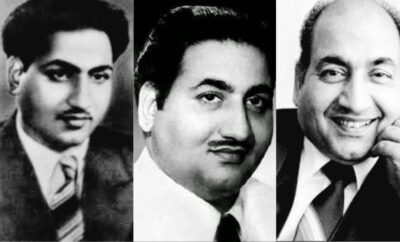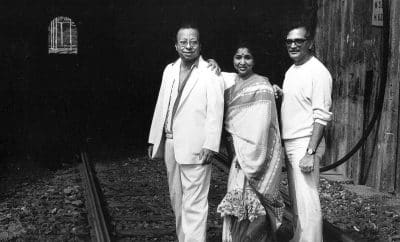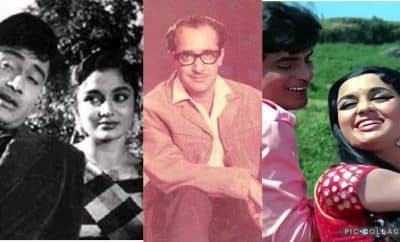Collections
Hemant Kumar – The Century-Old Musical Legend
Unity in diversity is one of the USPs of India, and Bollywood is its epitome. It has been happily taking people from all across the country under its wings. Amidst the cosmopolitan crowd in Bollywood, Bengalis have been instrumental right from the early years of the industry. Be it direction, be it acting or be it music, Bengalis have always made their mark. As Music is in their genes, their contribution to Bollywood music has been phenomenal. When we talk of Bengali music directors of golden era, who brought the petrichor of the Bangla soil to Hindi Film Music (HFM), Hemant Kumar is among the first few names to flash in our minds, alongside S.D. Burman and Salil Chowdhury.
Hemant Kumar was not only an adept music director of Hindi and Bengali film industry, but was also an accomplished singer. Uncomplicated, tranquil, soulful and sweet – that’s Hemant Kumar as a composer. And distinctive, deep and haunting – that’s Hemant Kumar as a singer. As he was steeped in Ravindra Sangeet, the inspiration and influence can be clearly seen in many of his tunes. He has made valuable and cherishable contribution to both Hindi and Bengali film music through his sublime compositions and unparalleled rendition.
Here is a modest attempt to pay tribute to this legendary artiste on his birth centenary through some of his Hindi compositions that have their roots in his own Bengali compositions.
1. Chhup Gaya Koi Re (Champakali – 1957)
Champkali was a costume drama portraying a story of sublime love and sacrifice, starring Suchitra Sen and Bharat Bhushan in the lead roles. The film had a Lata-dominated sound track, with “Chhup gaya koi re door se pukar ke” being the most popular song, counted amongst the Lata-classics. As the song depicts the grief of partition of the lovers, Hemant Kumar has composed Rajinder Krishan’s words in a tune full of pathos, based on raag Jhinjhoti. Hemant Kumar has enhanced the poignancy with the prelude and interludes comprising only flute, which, albeit a tiny looking instrument, has an astounding capability to effectively create various shades of joy as well as pathos. Muffled percussion seems like a heart beating heavily with the sorrow and Lata Mangeshkar’s heart wrenching rendition takes the composition to another level.
The tune was originally composed by Hemant Kumar for the Bengali song “O baanshi te daake she” from the movie Suryamukhi (1956). The Bengali song, penned by Gauriprasanna Majumdar and sung by Hemant Kumar, is a love song, expressing a woman’s longing to meet her lover clandestinely, who is calling her through alluring flute; and her dilemma – the alluring call on one side and social restrictions on the other.
https://www.youtube.com/watch?v=7fhWc1nmIec
2. Na Jao Saiyan Chhuda Ke Baiyan (Sahib, Bibi Aur Gulam – 1962)
Sahib, Bibi Aur Gulam – a masterpiece produced by Guru Dutt and directed by Abrar Alvi – shows the tragic fall of feudalism in Bengal during the British Raj. Though the film was flop at box office, it received a good deal of critical acclaim. Meena Kumari’s performance as Chhoti Bahu in the film is considered as one of the finest performances of Hindi cinema. Of all the beautiful songs composed by Hemant Kumar and penned by Shakeel Badayuni for the film, the fabulous song “Na jao saiyan chhuda je baiyan” is popular even today and considered as one of Geeta Dutt’s best songs.
The song is a poignant expression of expectations and deprival of Indian women, often ignored and taken for granted. Chhoti Bahu, craving for the husband’s company, compromises her basic values and morals; and consumes alcohol as a desperate attempt to keep home her unfaithful husband, who regularly resorts to prostitution and alcohol under the misconceptions and conceit about manhood.
Meena Kumari’s splendid performance and her drooping heavy look are more than aptly supported by Geeta Dutt’s amazing rendition. This is a brilliant example of acting as well as proficient playback singing. Hemant Kumar has beautifully decorated the tune with minimal orchestration mainly comprising sitar, flute and tabla.
This song is based on the tune of a simple but sentimental Bengali love song composed and rendered by Hemant Kumar as a Puja song released in 1960 – “Oliro kotha shune bokul haashe”, again penned by Gauriprasanna Majumdar.
3. Meri Baat Rahi Mere Man Mein (Sahib, Bibi Aur Gulam – 1962)
This is another melodious, but deeply melancholic song from Sahib, Bibi Aur Gulam, pictuirsed on another female lead in the film, Waheeda Rehman. It expresses her despair and distress owing to losing someone close, just because she could not speak her heart out in time.
Hemant Kumar has woven Shakeel Badayuni’s words in a tune drenched in sorrow; and Asha Bhosle has done full justice to the mood through her emotional rendition and stunning ability to go under the skin of any character that she sings for. The intensity of the sentiment hits you right from Asha Bhosle’s opening lines sung in a high pitch. Waheeda Rehman has brought the sentiment to life with her expressive face and proficient acting.
Would you believe that the tune was originally composed by Hemant Kumar for a romantic and nimble Bengali love song – “Ami door hote tomarei dekhechhi” – another Puja song penned by Gauriprasanna Majumdar? Just see how cleverly Hemant Kumar has converted the same tune into a song full of sadness!
4. Man Mera Udta Jaye (Maa Beta,1962)
Maa Beta, a classical crime film produced by “Rajshri”, starred Manoj Kumar, Ameeta, Nirupa Roy and Tarun Bose in the lead roles. The soundtrack has a beautiful but lesser known Lata solo – “Man mera udta jaye” – penned by Prem Dhawan. It is a classical song pitcurised on Nirupa Roy who is seen performing it in a program on the screen. The orchestration comprising dholak, sitar and flute is in consonance with Hemant Kumar’s minimalistic approach, but is quite suitable for a classical song. Lata Mangeshkar has rendered the song with her usual proficiency and sweet voice, taking care of all the nuances and various shades of emotions like happiness, excitement, anxiety and determination to break free from restrictions.
The tune of this fast paced song has its roots in a relatively slow paced song from Ravindra Sangeet – “Mono mor meghero shongi” composed in raag Malhar. Nature is always at the centre in Ravindranath Tagore’s poetry, and this song is not an exception. The song concisely and beautifully describes the bounties of nature, which the poet sees through imagination, as if his mind is flying across the sky with the clouds and birds. Hemant Kumar’s rendition of the song is simply mesmerising.
5. Ek Baar Zara Phir Kah Do (Bin Badal Barsaat, 1963)
Bin Badal Barsaat was a horror and mystery film starring Asha Parekh and Biswajit Chatterjee in the lead roles. The soundtrack composed by Hemant Kumar has a few euphonious songs written by Shakeel Badayuni.
Out of these, “Ek Baar zara phir kah do” is a lilting, playful and romantic duet by Lata Mangeshkar and Hemant Kumar – combining masculine unabashed expression of love and the feminine bashfulness. The frisky tune is ornamented with pleasant orchestration comprising instruments like santoor, sitar, flute and violins. The juxtaposition of the contrasting elements – Hemant Kumar’s deep, baritone voice and Lata Mangeshkar’s thin, saccharine voice – only enhances the beauty of this song.
By the way, could you feel the traces of the antaras of “Meri baat rahi mere man mein” in the antaras of this song?
The tune is the replica of the super hit romantic Bengali song “Ei poth jodi na shesh hoy” composed by Hemant Kumar for Saptapadi (1961). The song was written by Gauriprasanna Majumdar, rendered by Hemant Kumar with Sandhya Mukherjee and picturised on the lead pair of the film, Uttam Kumar and Suchitra Sen.
6. O Beqaraar Dil (Kohraa, 1964)
Kohraa, produced by Hemant Kumar, was a thriller horror film starring Biswajit Chatterjee and Waheeda Rehman in the lead roles. The story of the film was adapted from Daphne du Maurier’s celebrated novel Rebecca. The soundtrack of the film has four haunting songs, two rendered by Hemant Kumar himself and two by Lata Mangeshkar.
Anticipation and anxiety are like yin and yang, two sides of the same coin. While we take joy in anticipating future pleasures, we are also anxious due to the evanescing pleasures or due to the sorrows that are likely follow. At times, we therefore prefer to be happy in the status quo, though it may not be looking quite promising. Out of the two Lata solos in the film, the hypnotic song “O beqaraar dil” brings this perpetual tug-of-war, this restless relish to life. The compositon based on raag Bhimpalasi is decorated by Hemant Kumar mainly with violins and flute and poetically rich words flowing from Kaifi Azmi’s pen. Waheeda Rehman’s expressive acting and beautiful visuals of nature make this song a visual treat too.
https://www.youtube.com/watch?v=KxOGhSp1oEU
The original Bengali version was composed by Hemant Kumar for the movie Neel Akasher Neechey (1959) – his first movie production venture. The lyrics were written by Gauriprasanna Majumdar and the song was sung by Hemant Kumar himself. It is a poignant, philosophical number addressed to a river, asking the river about her origin and her wayward, tireless journey towards the sea.
7. Ye Nayan Dare Dare (Kohraa, 1964)
One of the two Hemant Kumar solos in Kohraa, this is a romantic song wherein the hero asks the heroine to shed all the inhibitions and allow him to make love fearlessly. The bewitching tune is beautifully supported by pieces of flute and violins and guitar strums in the interludes and between the lines; and Kaif Azmi’s befitting words. Hemant Kumar’s rendition in his captivating voice with unfathomable depth makes this song ethereal. The visual of the song is a fascinating presentation of Waheeda Rehman’s adorned as well as unadorned beauty, young and handsome Biswajit Chatterjee eagerly persuading her and their subtle romance in a palatial room covered from all sides with semi-transparent curtains swaying with the wind.
The composition is so enchanting that even the two empresses of Bollywood music, Lata Mangeshkar and Asha Bhosle, and the ghazal maestro Jagjit Singh could not avoid the temptation of singing it in public performances / recording it in their own voices.
The tune was prepared by Hemant Kumar many years before Kohraa, for the Bengali song “Ei raat tomar aamar (Deep Jwele Jai, 1959)”. Again, the song was rendered by Hemant Kumar himself and is regarded as one of the greatest and sensuous love songs in Bengali films. The song was written by Gauriprasanna Majumdar.
Deep Jwele Jai was remade in Hindi as Khamoshi (1969). The song “Ei raat tomar aamar” is parallel to the Hindi song “Tum pukar lo” from Khamoshi. Though the tune of “Tum pukar lo” is different from “Ei raat tomar aamar”, the prelude of the Bengali song (humming and a piece of santoor) is used as it is in “Tum pukar lo”. Thus, the songs “Ei raat tomar aamar”, “Ye nayan dare dare” and “Tum pukar lo” are closely interconnected.
8. Sawan Mein Barkha Sataye (Biwi Aur Makan, 1966)
Biwi Aur Makan was one of the finest but underrated comedy movie produced by Hemant Kumar and directed by Hrishikesh Mukherjee, starring Bisjwajit Chatterjee, Kalpana Mohan, Mehmood and Kesto Mukherjee in the lead roles. The movie was remade in different languages including Marathi (a celebrated comedy movie Ashi Hi Banwa Banwi, 1989), Hindi (Paying Guests, 2009) and Bengali (Jio Pagla, 2017).
“Sawan mein barkha sataye” is a romantic song expressing the yearning for the beloved in the rainy season. The song is embellished with mellifluous pieces of sitar and sung by Hemant Kumar himself. The lyrics written by Gulzar are pretty simplistic, probably because the film was made in the initial years of career, before he had completely developed his unique outstanding style.
Hemant Kumar had composed the tune originally for the Bengali song “Ashad shrabon, mane nato mon” which has a similar mood as the Hindi song, for the family drama movie Monihar (1965). The lyrics were written by Mukul Dutta and the song was sung by Lata Mangeshkar.
9. Janam Se Banjara Hoon Bandhu (Rahgir, 1969)
Rahgir was a romantic social drama film, a Hemant Kumar production, portraying the story of a young nomad trying to find the meaning of life. Biswajit Chatterjee and Sandhya Roy played the lead roles in the film.
“Janam se banjara hoon bandhu” from Rahgir is another lesser known enamouring song composed and sung By Hemant Kumar. The song written by Gulzar perfectly describes a nomad’s philosophy. The lyrics inevitably remind us of another classic written by Gulzar – Musafir hoon yaaron (Parichay, 1972), wherein Gulzar has painted a similar word-picture. But the transition from a simplistic style to the unique Gulzar style full of unconventional imagery can be clearly seen when the two songs are compared.
https://www.youtube.com/watch?v=L4rLPXaqBKs
Rahgir was a remake of the Benagli film Palatak (1963). “Janam se banjara hoon bandhu” is the parallel of and composed in the same tune as the song “Jibonpurer pothik re bhai” from Patalak, which is also rendered by Hemant Kumar himself. The song was penned by Mukul Dutta.
https://www.youtube.com/watch?v=lSh0W5-k5qQ
10. Dost Kahan Koi Tumsa (Khamoshi, 1969)
Khamoshi, also produced by Hemant Kumar, was a drama film starring Waheeda Rehman, Dharmendra and Rajesh Khanna in the lead roles. As mentioned earlier, it was a remake of the Bengali film Deep Jwele Jai (1959).
In this comic song, a drunkard patient (played by Deven Verma) is praising the liquor. The song is rendered by Manna Dey and written by Gulzar. Manna Dey sang all types of songs – whether romantic, classical or comedy – with equal proficiency and this song is no exception. The song subtly reminds of another Manna Dey number sung for R.D. Burman – “Abhi to hath mein jaam hai (Seeta Aur Geeta, 1972)”.
The parallel of the song in Deep Jwele Jai (“Emon bondhu aar ke aachhe”) was also rendered by Mann Dey and was written by Gauriprasanna Majumdar.
Hats off to the staggering craftsmanship of Hemant Kumar, now a century-old musical legend, in skillfully converting Bengali mishti into equally delicious Bambaiya mithai, without compromising on the essence!




Surojit Ray
June 16, 2020 at 11:50 am
Very well researched and beautifully penned. Hemant Kumar was a great and simple human being with his feet firmly grounded. His mesmerizing voice was unique and absolutely divine. This article is a much deserved tribute to the great composer and singer. Beautifully written.
Yogesh
June 28, 2020 at 8:55 pm
Thanks a lot, Surojit. Your comment is always valuable 🙂
Yes, HK was not only a great artist, but also a gem of a person.
Ajay Poundarik
June 17, 2020 at 2:59 am
In My Opinion and I rate Music Director HEMANT KUMAR, as the best music director came from the eastern part of India, NO MEDIA hype. I am surprised nothing is mentioned about the top musical score of NAGIN, 1955. NAGIN songs rocked the nation. As said Hemant Kumar is one of my favorite music directors. He was outstanding in “Sahib Bibi Aur Ghulam”, “Bohra”, “Bees Sal Baad”,,,I even liked his musical score in “Do Dil”, 1965, in particular a very romantic song sung by Mohammad Rafi and written by Kaifi Aazmi. ( Tera Husn Rahe Mera Ishq Rahe). Anyway, it is good writeup. Keep it up.
Yogesh
June 28, 2020 at 8:54 pm
Thanks Ajay ji. The songs of Nagin nowhere fit the theme of the write up (Hindi songs converted from HK’s Bengali tunes).
Pingback: Carnival of Blogs on Golden Era of Hindi Film Music – June 2020 – The world is too small? or Is it?